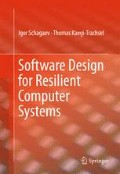Abstract
This chapter introduces what design principles and application requirements we need to pursue achieving resilient functioning of computer system. Principle of simplicity, reliability, reconfigurability, scalability, and redundancy are briefly discussed. Shown that implementation of principles with architecture might include system software modification as well as redevelopment of basis hardware blocks—processing area, storage area, and interfacing area of computer system.
Access this chapter
Tax calculation will be finalised at checkout
Purchases are for personal use only
References
Laprie J-C et al. (2001) Basic concepts and taxonomy of dependable and secure computing, IEEE Trans Dependable Secur Comput 1(1):11–33, January–March 2004
Sogomonian E, Schagaev I (1988) Hardware and software fault tolerance of computer systems. Avtomatika i Telemekhanika, pp 3–39
Pliaskota S, Schagaev I (1995) Economic effectiveness of fault tolerance. Autom Remote Control 7:2
Schagaev I (1989) Instructions retry in microprocessor recovery algorithms. In: IMEKO—FTSD symposium
Pliaskota S, Schagaev I (2001) Life cycle economic efficiency analysis. In: IEEE TESADI-01
Schagaev I (2008) Reliability of malfunction tolerance. In: International Multiconference on Computer Science and Information Technology, IMCSIT, pp 733–737
Wirth N, Gutknecht J (1992) Project Oberon: the design of an operating system and compiler. Addison-Wesley, New York
Johannes M (2002) The active object system—design and multiprocessor implementation. ETH Zurich, Zurich 4, 82, 109, 173
Mossenbock H, Wirth N (1991) The programming language Oberon-2. Technical report, Johannes Kepler Universitat Linz
Reiser M, Wirth N (1992) Programming in Oberon: steps beyond Pascal and Modula. Addison-Wesley, Wokingham
Wirth N (1977) Modula: a language for modular multiprogramming. Softw: Pract Experience 7(1):1–35
Wirth N (1985) Programming in Modula-2. Springer, New York
Wirth N (1971) The programming language Pascal. Acta Informatica pp 35–63
Wirth N (1977) The use of Modula. Softw.Pract Experience 7
Kaegi-Trachsel T, Gutknecht J (2008) Minos—the design and implementation of an embedded real-time operating system with a perspective of fault tolerance. In: International multiconference on IMCSIT 2008, pp 649–656, 20–22 October 2008
Schagaev I et al. (2007) Applying the principle of active safety to aviation. In: European Conference for Aerospace Sciences (EUCASS)
Schagaev I et al. (2010) ERA: evolving reconfigurable architecture. In: International Conference on 11th ACIS, pp 215–220
Author information
Authors and Affiliations
Corresponding author
Rights and permissions
Copyright information
© 2016 Springer International Publishing Switzerland
About this chapter
Cite this chapter
Schagaev, I., Kaegi-Trachsel, T. (2016). Introduction. In: Software Design for Resilient Computer Systems. Springer, Cham. https://doi.org/10.1007/978-3-319-29465-0_1
Download citation
DOI: https://doi.org/10.1007/978-3-319-29465-0_1
Published:
Publisher Name: Springer, Cham
Print ISBN: 978-3-319-29463-6
Online ISBN: 978-3-319-29465-0
eBook Packages: EngineeringEngineering (R0)

